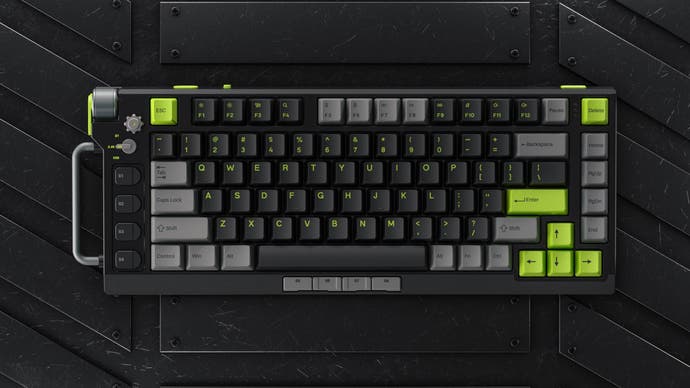Tiny screens, wild colours and magic knobs: 2023 keyboard trends
Six mechanical keyboards reviewed from Nuphy, Drop, Nubia, Ranked, Mikit and JamesDonkey.
Even if you're not a mechanical keyboard fanatic, it's fun to keep tabs on what's happening in this famously creative and competitive cottage industry. Previously, we spotted the debut of gasket-mounted and foam-filled keyboards that upgraded the typing experience, plus some truly strange layouts all the way down to tiny 40 percent size options that fit in a jeans pocket. New for 2023? It's tiny full-colour displays, eye-catching hues and powerful knobs - if the keyboards I've been testing recently are any indication.
Here are short reviews of the six most interesting keyboards that have passed over my desk so far in 2023, from sci-fi designs with cruel and unusual colour schemes to hearty, tank-like models made even heavier with the addition of brass weights. You might not find your keyboard here, but some of the trends pioneered by these more boutique brands are sure to arrive on more mainstream designs too - so take a look at the future, in roughly ascending order:
6. Nubia Redmagic GK001J

After testing quite a few tasteful keyboards last year with stylish, retro-inspired designs, I was happy to see the Nubia Redmagic GK001J - a keyboard that runs shamelessly headlong into the gamer aesthetic.
Pretty much every stereotype is fulfilled here: metal accents, superfluous RGB lighting zones, a tiny colour screen in the upper right, a 'smart knob' and RGB-emitting pudding keycaps with a collection of fonts, symbols and colours that wouldn't look out of place in a sci-fi cockpit. The overall effect is a little overwhelming - but is sure to delight its target audience. The GK001J feels reasonable to use too, despite its compacted 100-key layout and silver (soft, short, linear) key switches. Switch maker TTC isn't the best-respected producer of Cherry MX clones, but these are at least hot-swappable if you love the design but want a different feel.
The 1.47-inch LCD screen in the upper right is perhaps the most interesting feature, and shows a clear progression beyond the monochrome OLED display built into SteelSeries' Apex Pro keyboards. Using the knob to the right, you can swap between a volume read-out, performance metrics (requiring Windows software) and backlighting controls; a battery readout and connection info are also visible. This works well enough, and I wouldn't be surprised to see more mainstream brands adopt something similar - but perhaps a little more polished - in future.
Unfortunately, both the £169 GK001J and the £79 Redmagic mouse that was also shipped to me seem to suffer from connectivity issues, with the 2.4GHz mode suffering frequent drop-outs on multiple machines - unless I set the backlight brightness to the lowest possible level. The wired mode works fine, thankfully, but it looks like a firmware update is necessary to solve the issues - the absence of which precludes me from recommending these peripherals at present, especially given their premium prices.
5. Ranked Nova n60 and Guardian g65
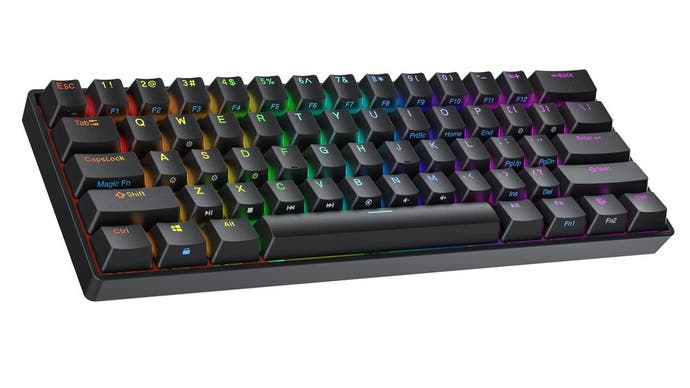
Ranked's Nova n60 and Guardian g65 keyboards are ordinary but good value options in 60 and 65 percent sizes respectively, with what I would consider to be the current standard features from boutique mechanical keyboards: hot-swappable Gateron switches, RGB backlighting, PBT keycaps, noise-dampening foam, an aluminium frame and a detachable USB-C cable. This results in a pleasant keyboard to use, although the lighter chassis leads to a slightly hollow feeling compared to the heftier alternatives elsewhere in this article. This is at least understandable for keyboards that are also significantly cheaper than their in-page rivals.
Where the keyboard sets itself apart is by offering QMK and VIA firmware support, allowing for customisation and incredible programmability, and a "tap mode" feature on the 60 percent size that grants easy access to the arrow keys by tapping the Shift, Fn, Menu and Ctrl keys. This is super smart and basically makes 60 percent a viable form factor for me - even if the wide shift key doesn't make the best up arrow I've ever seen. There's also the 'Magic Fn' feature (which we've seen on earlier keyboards like the Anne Pro 2) which turns the Caps Lock key into another Function key when held down - another smart option, although it didn't seem to work in MacOS. Speaking of which, there's no quick toggle for Mac compatibility, but you can swap around the modifier keys in the keyboard settings, which is remembered for future use.
Ranked's $70 Nova n60 and Guardian n65 keyboards are worth considering if the price is right then, but I'm really looking forward to their analogue Master keyboard that should offer a similar experience to the Wooting 60HE at a lower price - while continuing the theme of naming keyboards after Counter-Strike: Global Offensive ranks, something I'm obviously all in favour of.
4. JamesDonkey RS2 3.0

We actually looked at the JamesDonkey RS2 in another keyboard roundup last year, but today we've got the sequel in - the awkwardly/awesomely named JamesDonkey RS2 3.0. This revision adds a colour status screen (with the date, time and battery life) to the upper right of the keyboard and trades the retro look of the original for a crisper white and blue design. The modern stylings make this keyboard a little harder to pick out of a lineup, but the screen is easier to use for adjusting keyboard settings than the often arcane key combinations common to boards that don't come with their own software.
Otherwise, it's much the same, a 99-key design with a large volume wheel in the upper right. As with other keyboards on this list, all of the common feature boxes are ticked: tri-mode connectivity, a Mac/Windows switch, PBT keycaps, hot-swappable Gateron G Pro 2.0 switches, noise-dampening foam and a gasket mount design; all of which results in a comfortable keyboard that perhaps doesn't quite hit the highs of the Drop Sense75 or Mikit DK65 keyboards below but still easily outperforms the average mechanical keyboard at the $100 mark.
Given its lower price compared to the Nubia keyboard above ($116 assembled or $86 as a kit), its better reliability and more widely acceptable design - the RS2 3.0 is an easy recommendation for anyone that wants to heark back to the glory days of the Logitech G15 with a keyboard that actually feels good to type on.
3. Drop Sense75
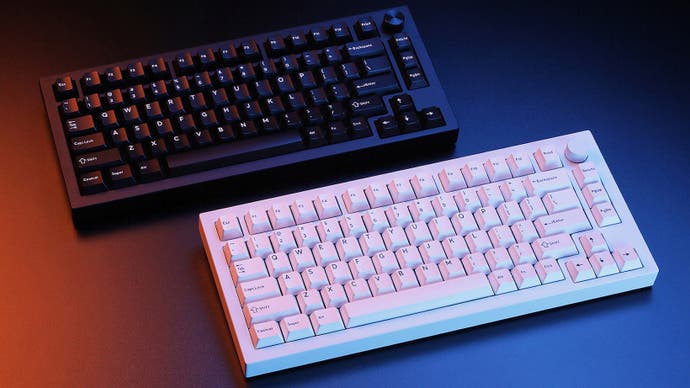
The Sense75 is Drop's flagship keyboard for 2023, a heavy duty option available as a $99 built-it-yourself kit or as a $149 preassembled keyboard. Rather than loud styling or questionably useful features, the focus here is on delivering a solid typing experience, courtesy of a home-grown gasket-mounted design, noise-dampening foam, an optional $79 brass plate and high-end switches and stabilisers. Of course, there are some premium value-adds too, including per-key RGB backlighting, diffused RGB underglow lighting and a chunky knob for all of your rotary encoding needs.
Once assembled, the Sense75 weighs an absolute ton for an 84-key keyboard - the brass weight alone is nearly a kilogram! - and feels flex-free, firmly planted and super premium thanks to its metal body. Typing quickly produces a convincingly deep report, the unique DCX profile keycaps feel way better than you'd expect for ABS and the knurled metal knob with Alps encoder beneath is the best I've ever felt on a keyboard.
The Sense75 is a brilliant keyboard, with only its high price ($149 + $79 for the configuration I tested) really holding it back from a higher spot on this roughly-ordered list. The look, feel and sound of this keyboard are certainly beyond reproach.
2. Nuphy Field75
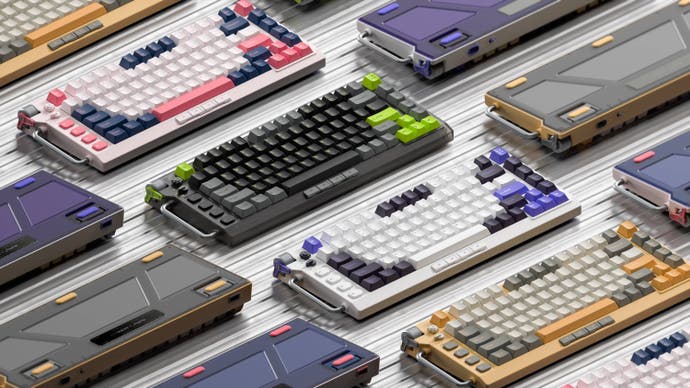
Nuphy creates some of the most stylish keyboards around, while delivering the mechanical feel and wide OS compatibility that makes them an easy upgrade for people that wouldn't have considered a gaming-spec keyboard. Their latest effort, the Field75, takes a less minimalist tack - with a handle, volume wheel, macro keys and eye-catching colourways. It's an interesting play that could see Nuphy expand their audience - but does it deliver?
In short, yes. The busier 'dieselpunk' design suits me down to the ground, especially in the green and pink colourways, and the extra macro keys are a fantastic addition - especially the ones plunked right under the space bar, ready to activate at a moment's notice. Typing on the coloured PBT keycaps feels good, with the soft Polaris switches providing rapid actuation suitable for gaming too, and there are good alternate switch options both at the time of purchase or afterwards thanks to hot-swappability.
The volume wheel isn't the best, as it's plasticky and on the left side of the keyboard rather than on the right as I typically prefer, but the second wheel to adjust the backlight brightness and the three-way DIP switch for selecting connectivity modes work nicely - and are far better than reflecting the current mode using subtle shifts to the backlight as many other keyboards do.
At $153 (w/ code DF10), the Field75 isn't the best value keyboard on this list, but it's certainly one of the best-looking - and that's backed up with genuinely useful additions in the form of the connectivity switch, volume wheel and macro keys and a top-tier typing experience, complete with the usual macOS support. This one seems destined to be another influencer classic, that's for sure.
1. Mikit DK65 Currant
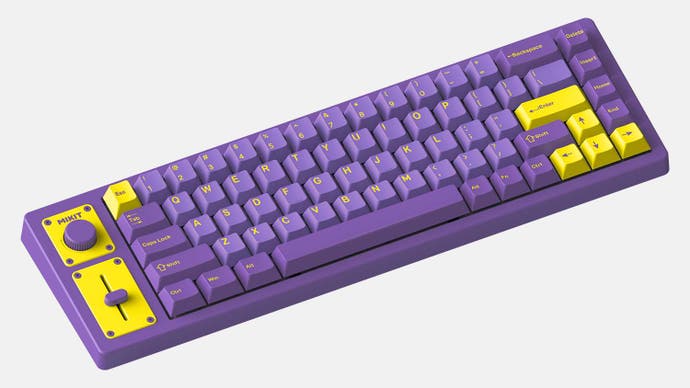
We've saved the best for last here, I think. The $99/£85 Mikit DK65 Currant is a delightful keyboard that takes up minimal vertical space but stretches languidly along the horizontal, providing a 65 percent layout with arrow keys plus a fader (for backlight brightness) and knob (for volume control and muting) on the left side. This combination makes it much more comfortable - and satisfying! - to use than your average compact keyboard, with only Print Screen and F keys requiring use of the Function layer. The keyboard is stylish too, although the purple and yellow colourway may not be everyone's cup of tea. For me, it matches the Lakers and even the fictional Konnersport Racing team from F1 23, so I'm perfectly happy with it.
Internally, the DK65 hits all of the new trends - gasket-mounted and hot-swappable switches (Gateron G Pro 2.0 in various flavours by default), a 4000mAh battery providing a choice of Bluetooth, 2.4GHz and detachable USB-C wired connections and 50 days of reported battery life, RGB backlighting to reduce that battery life, n-key rollover and legs that allow for elevated or flat keyboard profiles. The DK65 is heavy for its small size and feels extremely well-built too. The keyboard feels great to type on, with the Brown switches in our sample providing a nearly linear experience with just a hint of tactility and the PBT keycaps providing long-lasting texture.
Unfortunately, the RGB backlighting just looks cool rather than actually making the keyboard usable in low light as the keycaps provided aren't shine-through. Still, it keeps your options open if you prefer to replace the stock keycaps, and with a typing experience this good it's not a serious complaint. The bigger disappointment is that the fader can't be tied to other functions; it would be great as a way to quickly boost or mute your microphone or adjust the volume of a specific app (eg Discord). This sort of functionality is promised, but it remains to be seen when or if this will arrive and how flexible it will be.
Regardless though, this is a cracking little keyboard and at $99 it's good value too - I'd certainly take this over a cookie-cutter mechanical gaming keyboard any day.
I'm always on the lookout for more interesting keyboards to test, so feel free to get in touch via Twitter (@wsjudd) or via the comments below if you have any suggestions.
